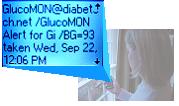We've Moved

Thoughts about current approaches to managing diabetes with an emphasis on overcoming barriers through the application of new technology. There is also an emphasis on psychology as the key to making strides in the world of patient managed chronic disease. And finally, not nearly enough clinical research has been translated to every day practice. The goal of this blog is to help accelerate progress in this area.


 Folks in our trials tell me they really like the GlucoMONTM for its real-time alerts and the fact that it isn't limited to the home. It goes with you during your day. Our current trials are the best examples of pervasive technology at play outside of the hospital for people with medical conditions.
Folks in our trials tell me they really like the GlucoMONTM for its real-time alerts and the fact that it isn't limited to the home. It goes with you during your day. Our current trials are the best examples of pervasive technology at play outside of the hospital for people with medical conditions. Diabetes House Call to the rescue
"There are more than 100 families in the Fredericksburg area who have children with this chronic disease, and we must travel over 100 miles round-trip for our children to be seen."
This from a mom who has raised probably over a half-million dollars for research since her daughter was diagnosed over 15 years ago. Meanwhile, every 3 months they stop what they're doing, get in the car, travel to the specialist, sit in the waiting room and then if they have the same kind of visit as many other families that I know, they will spend more time paying their co-pay than they do with the endo. It's commonplace to spend no more than 5 to 10 minutes with the doctor and only twice a year in many settings. Most of the time is spent waiting and then only to be seen by the diabetes nursing staff.
"...there are a lot of children here in need of this type of specialist. We are getting tired of waiting. There are veterinarians virtually on every corner in this town. Why can't we get one good endocrinologist for our kids?" says Lisa Taylor, mother of the 16 yr old w type 1."
What if you could have a telemedicine visit with your endo from home for visits when everything is going well? That's what we're testing in Texas with Diabetes House Call™. It's cool stuff and will be coming to people in a few additional states by mid next year - the lucky families living in Texas will have access to DHC this year!
To see Diabetech's current published clinical trials click here:
Patient Reported Data - true, false or somewhere in between?
When Is Continuous Not Really Continuous?
What if you only knew how a loved one was doing at any given moment in time? Would that be more interesting than getting a text message about Google's stock price? Maybe. What if you were a physician and you just told the patient to change their medication dosage (ie - insulin)? Wouldn't you (shouldn't you) be interested to know the effects of that recommendation...as it unfolds?
 Continuous Glucose Monitoring Goes Small!
Continuous Glucose Monitoring Goes Small!

 Web, TV, Text Messaging, Email, Now Radio, too!
Web, TV, Text Messaging, Email, Now Radio, too!
Challenge Diabetes Goes Mobile!
Have you ever stopped to think about how ironic it is that so much diabetes management & education requires the patient to sit in front of a computer? Let's think hard going forward how to make healthcare tech mobile.
 Share the Data - Step 2 of the Virtual-Loop(TM)
Share the Data - Step 2 of the Virtual-Loop(TM)
 Get The Data - Step 1 of the Virtual-Loop
Get The Data - Step 1 of the Virtual-LoopPlease...
diabeticfeed has the scoop
 operation cure the kids
operation cure the kids
 Let's call it GlucoPALS
Let's call it GlucoPALSNext Year's Camp Resolution
Hello Camp - Good Bye Sleep